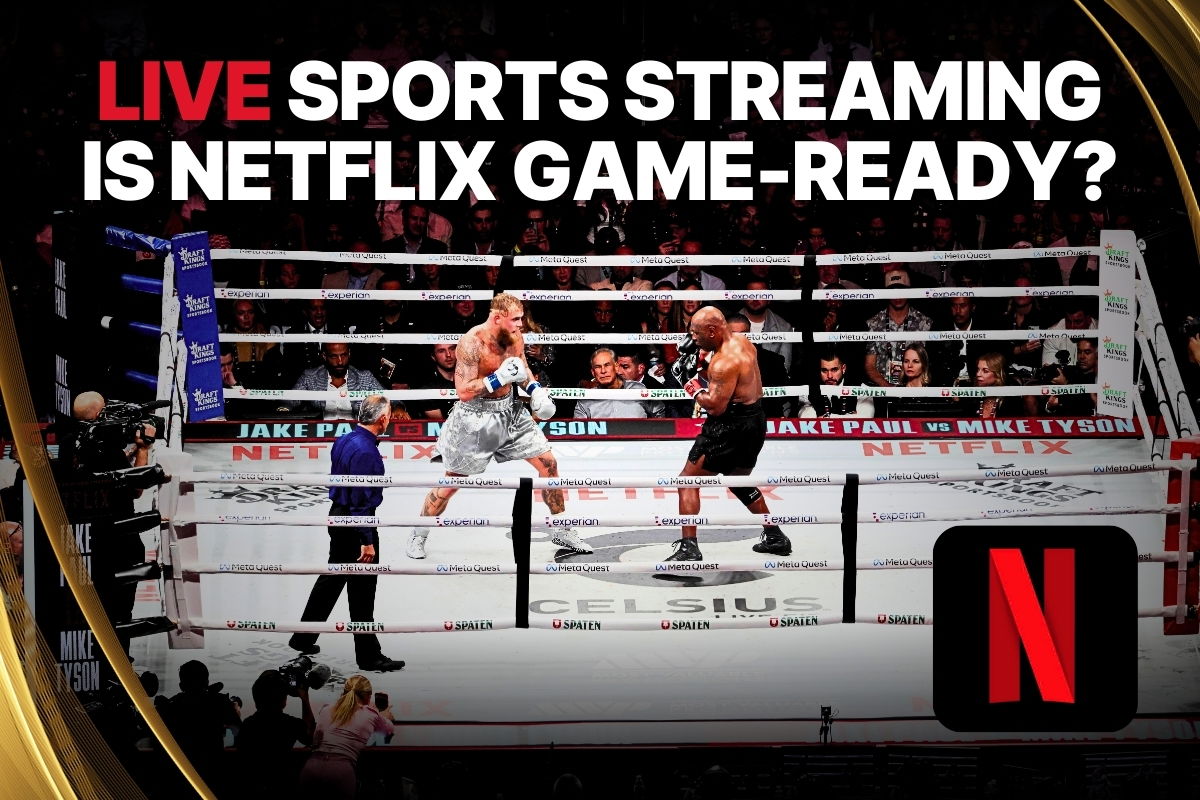

This flagship article was co-written by its editor, Mallika Singh
Watch What’s Trending Now!
Gone are the days of passive sports watching. From an extensive library of post-theatrical content to leading in exclusive originals, streaming platforms have reshaped entertainment consumption. Now, live sports—the last bastion of traditional TV—is the newest frontier. Joining this revolution is Netflix, diving headfirst into the high-stakes world of live sports streaming.
After the Jake Paul vs. Mike Tyson showdown, Netflix is signaling its readiness to compete. But can the streaming giant turn live sports into its next big win?
ADVERTISEMENT
From Binge-Worthy Dramas to Live Sports: Netflix’s Next Frontier
Netflix’s move into live streaming came after a big drop in its subscriber count in 2022. Reportedly, the company lost nearly 200,000 subscribers globally. This was seen as Netflix’s first major loss in ten years, sending its shares tumbling by a whopping 40%. In March 2023, Netflix debuted its global live-streaming service with the stand-up comedy special, Chris Rock: Selective Outrage. But streaming sports live had still not been put on the table.
Netflix’s first venture into sports was through documentaries/docuseries. Its first sports docuseries, Last Chance U, was released in 2016. However, even in 2022, the company showed no interest in live sports. Netflix co-CEO and chief content officer, Ted Sarandos shared at the UBS Global TMT Conference in New York City, “We’ve not seen a profit path to renting big sports.” However, Sarandos also mentioned, “We’re not anti-sports, we’re just pro-profit,” with a small caveat of “never say never.” Over time, as the market for sports documentaries became overcrowded, Netflix had to find a way to stand out.
ADVERTISEMENT

ADVERTISEMENT
That was when live sports streaming finally came into the picture. On January 23, 2024, Netflix revealed it had secured the international rights to WWE’s Raw. The ten-year agreement, starting in January 2025, was valued at $500 million per year and covered WWE’s key weekly programs and live events. Then in May, it made another three-season deal with the NFL to air the Christmas Day games with CBS Sports, which reportedly cost the streamer about $75 million per game.
Top Stories
Josh Allen Makes Lifetime Buffalo Announcement as Pregnant Hailee Steinfeld Receives Bills QB’s Clear Family Plan

NTSB Appeals for Greg Biffle’s Wife’s Alleged In-Flight Text Messages as Crash Investigation Heats Up

Travis Kelce Reveals Real Reason Behind Decision to Snub the Media Amid Retirement Rumors

Sean Strickland Passes on UFC White House Opportunity in Yet Another Bold Confession

Donald Trump Issues Moving Message of Condolence for NASCAR’s Greg Biffle & Family During North Carolina Address

Another Almost Fatal Disaster Surfaces From Statesville Airport Amidst Ongoing Greg Biffle’s Crash Investigation

Speaking about this new venture, Bela Bajaria, Netflix’s chief content officer, said in a statement to Tudum, “Last year, we decided to take a big bet on live — tapping into massive fandoms across comedy, reality TV, sports, and more”. David Murray, a sports-rights consultant, explained to The Athletic earlier this year that Netflix’s decision was driven by flatlining subscriber numbers and the potential of live sports to attract new audiences. Murray stated, “live sport can be really valuable is providing regular content that people want to watch”.
ADVERTISEMENT
A research manager at Ampere Analysis and sports-rights expert, Jake Henovese, further pointed out after Netflix’s NFL deal that “time spent watching content is now way more important”. He added, “For that, sports can be massive”.
But how has Netflix done with live sports streaming so far? Let us break it down with two key live sports events.
ADVERTISEMENT
Hitting or Missing the Mark: Case Studies in Live Streaming
Mike Tyson vs. Jake Paul
The Mike Tyson vs. Jake Paul showdown on Netflix was iconic for many reasons- not just because of the interesting story of how the fight came together, but also because it was a clear battle of youth versus experience. Here is how Netflix managed the live streaming.
- The live event brought in 108 million viewers worldwide. It received 65 million concurrent streams, and 38 million of those came from the US. For the first week, it was the most-watched title on Netflix, reaching 46.6 million views by Sunday night. Netflix claimed in Tudum’s article that this made it the “most streamed global sporting event in history.”
- Netflix had earlier reported that the heavyweight boxing match was watched by 60 million households worldwide, while 50 million households globally tuned in live for the co-main event of Serrano vs. Taylor 2. However, later the OTT platform updated its facts and confirmed that the Taylor-Serrano fight averaged an estimated 74 million live viewers worldwide. With this viewership, it became the most-watched professional women’s sports event in US history.
ADVERTISEMENT
What worked
- Before the main event, there was an exciting match between Katie Taylor and Amanda Serrano. It featured several dramatic momentum shifts, fierce headbutts, and a controversial decision in favor of Taylor, that led to many unforgettable post-fight reactions all over social media.
- Netflix also made a strong push to promote and generate excitement for the fight, and it all paid off.
- The commentary in real time was spot on as well, which made the live experience even more engaging.
- The live event also sparked several meme-worthy moments. For instance, in the pre-match interview with Mike Tyson, he accidentally exposed himself on camera.

Getty
ARLINGTON, TEXAS – MAY 16: (L-R) Mike Tyson, Nakisa Bidarian and Jake Paul pose onstage during the Jake Paul vs. Mike Tyson Boxing match Arlington press conference at Texas Live! on May 16, 2024 in Arlington, Texas. (Photo by Cooper Neill/Getty Images for Netflix)
What did not work
ADVERTISEMENT
- Fans were frustrated by the company’s glitchy livestream.
- The match was also rumored to have been scripted and rigged. Much of the fight between Tyson and Paul involved them simply hugging, and there were no visible injuries, like a nosebleed. Carl Froch even told the Metro about a supposed contract that stated, “Tyson can’t even try and hurt him”.
- The fight was brief, and the spectacle, as per many fans, did little to justify the substantial financial compensation awarded to the parties involved.
ADVERTISEMENT
The Netflix Slam: Star Power Without Substance
Netflix aired a live tennis exhibition between Rafael Nadal and Carlos Alcaraz on March 3, 2024, dubbed The Netflix Slam:
- It failed to make Netflix’s global top 10 or draw significant buzz.
- Nonetheless, FlixPatrol, the VOD measurement company that tracks over 800 streaming services in over 160 countries, released a report suggesting that the live event performed best in Spain, which was quite obvious given that the two players were from there.
What worked
- The best part of the livestream was its star-studded spectacle. It is not every day you see Andy Roddick and Andre Agassi- arguably the game’s top pundits- sharing the same studio. This drew a lot of attention from fans.

Imago
Image courtesy – Imago
What did not work
- Many tennis fans argued that Netflix does not truly understand them or what they want to see, as evidenced by the underwhelming documentary Break Point earlier as well.
- There was no automatic line-calling. The first game was disrupted by audio feedback and TV commentary blaring through the arena speakers. Many fans pointed out that the court had visible streaks from sloppy painting, the trophy was unimpressive, and the production felt cheap. The grey court looked dull under harsh lighting, and the points challenge system showed blurry black-and-white replays.
The Roadblocks to Becoming a Sports Powerhouse
Inaccessibility
- Netflix’s live sports streaming is not available to everyone at all times. Some devices that can stream shows and movies do not support live events. This happens when either the Netflix app or the device’s software cannot be updated for live streaming.
Quality
- Streaming high-definition and 4K video to multiple people at once can be difficult.
Tech Blunder
- Netflix has hosted several live streams by now, but it is still struggling to fix its technical glitches. This was especially obvious during the recent Mike Tyson and Jake Paul match. Viewers reported buffering and streaming problems throughout the event. Downdetector, a site that tracks internet outages, received thousands of reports throughout the evening.
- These issues raise doubts about Netflix’s ability to handle live streaming reliably, putting its potential for subscriber growth in question as well- especially with the NFL Christmas Day games just over a month away.
- Even the markets seemed worried that this might not be a one-time issue. Netflix’s stock dropped over three percent after the Paul Vs. Tyson glitch. The Motley Fool Stock Advisor team also left Netflix off their list of the 10 best stocks to buy right now.
Competitors
- Amazon
Amazon began live streaming over three years ago and has already worked out its technical issues by starting with smaller rights in different markets. The company has also reportedly reached a deal with the NBA to broadcast major regular-season and postseason games. This contract would reportedly last at least a decade. According to CNBC Sport, Amazon is spending about $1 billion per year on the deal.
Thus far this season, Amazon’s TNF (Thursday Night Football) is drawing an average audience of 13 million viewers, showing a 4% improvement from the previous year. However, Amazon’s viewership is still below the 16.2 million record TNF achieved on Fox and the NFL Network in 2021. That said, Amazon’s sizable investments in exclusive sports rights give it a clear advantage over Netflix in the sports space.
- YouTube TV
YouTube TV, owned by Google’s parent company Alphabet, has grown into one of the largest live TV streaming platforms. The service has been making big investments in sports to attract more viewers. Earlier this year, YouTube TV completed its first season with the NFL Sunday Ticket, a service that lets fans watch every out-of-market game. YouTube also secured the rights from DirecTV with a deal reportedly worth $2 billion per year.
YouTube Live saw 15.2 billion hours of watch time in Q2 2024, a 20.5% increase from the previous quarter. Much of this growth was driven by sports events. YouTube’s free-access model and device compatibility further make it the dominant platform for live sports in global markets, particularly in Southeast Asia and Latin America, as compared to Netflix.
Peacock
In 2023, Peacock made history by hosting an exclusive NFL game on its platform for the first time. This exclusivity became the centerpiece of its marketing strategy and positioned Peacock as the go-to platform for the event. The NFL also benefited significantly and attracted a tech-savvy, younger audience while surpassing their viewership projections.
What does Netflix’s entry into live sports mean for its competitors?
- It will change how advertisers buy media. Those who usually focus on TV networks will have to consider digital platforms too. This shift could lead to more flexible and dynamic media buying.
- It will heat up competition for ad dollars. This could lead to better pricing models, giving advertisers more value for their money. Platforms that depend on ad revenue, like YouTube, may also need to boost targeted advertising opportunities around sports content.
- Netflix could spark heated bidding wars for top sports rights. This could reduce its competitors’ dominance in the live sports market while making it harder for smaller platforms to compete for big rights deals. As per a report from Mint, OTT content spending surged 52% in 2023 with sports rights.
- If Netflix succeeds in securing a hold on live sports, it may push traditional broadcasters such as NBC, CBS, or Sky Sports to double down on their own streaming platforms to keep up in the race.
- There could be a greater focus on niche sports or high-profile one-off events from other competitors, instead of just committing to expensive, recurring rights agreements.
What is Next for Netflix in Live Sports?
Netflix’s live sports streaming got a big boost with the Jake Paul vs Mike Tyson boxing match. The strong ratings led several Wall Street analysts to raise their price targets for Netflix stock. On Monday, the stock jumped 2.8% to close at 847.05 and kept climbing, finishing the day up 2.9% at 871.32, as per a report from Investor’s Business Daily.
CFRA Research analyst Kenneth Leon said in a client note that “Netflix is flexing its streaming capability with select live sporting events”. Leon also added that it is “expected to be a revenue driver by 2026”. Even with the promising outlook, there are a few issues the streaming giant still needs to sort out. Especially, its technical blunders.
According to Investopedia, even with the technical challenges, Netflix shares have gone up by 69% this year. This is a big jump compared to its competitors like Disney and Comcast.
Some experts, like Oppenheimer & Co. analyst Jason Helfstein, straight up brushed off the customer complaints. In a public note, he said the viewership was likely twice as large as the company had expected. Talking about the glitches, he said they are “a high-quality problem that can be easily fixed by Christmas Day.” Even Netflix CTO Elizabeth Stone shared similar sentiments and considered the event “a huge success” despite the technical issues.
Having said that, Netflix is not the only streaming platform struggling with technical issues. Amazon Prime’s Thursday Night Football season two premiere on Prime Video last year also faced major glitches. Awful Announcing, a sports analysis site, surveyed fans afterward on X, and the reviews were very mixed. Many fans complained about a poor viewing experience.
We’ve seen some people have some issues with the Amazon stream. How’s it working for everyone? If it’s not going well, what’s the issue? Feel free to include photos or videos.
— Awful Announcing (@awfulannouncing) September 15, 2023
Even livestreaming on YouTube has faced latency and buffering issues during high-traffic sports events.
The Verdict: Is Netflix Ready for Live Sports Primetime?
The Mike Tyson vs. Jake Paul fight proved that Netflix had a limited time to fix its latency issues before it fully takes on the role of sports rights holder. This was evidently visible in Netflix’s recent Christmas NFL games. These games got Netflix a TV-sized audience, with NFL Christmas games setting streaming records:
NFL Christmas Day Games: A Big Test for Netflix
Netflix’s NFL Christmas Day games marked a pivotal moment in its live sports streaming journey. The games, aired in partnership with CBS Sports, featured the Kansas City Chiefs vs. Pittsburgh Steelers and the Baltimore Ravens vs. Houston Texans. The stakes were high for Netflix, as these games not only tested its streaming infrastructure but also gauged audience reception to live sports on the platform.
Viewership and Performance
- Viewership Numbers: The Christmas Day games were a resounding success, attracting a combined unduplicated audience of nearly 65 million viewers in the United States, according to Nielsen. The Chiefs vs. Steelers game averaged 24.1 million viewers, while the Ravens vs. Texans game averaged 24.3 million viewers, making them the most-streamed NFL games in U.S. history.
- Peak Viewership: The Ravens vs. Texans game peaked at over 27 million viewers during Beyoncé’s halftime performance.
- Technical Performance: Netflix’s investments in technical improvements since its earlier live streaming glitches appeared to have paid off. While minor issues were reported, the overall streaming experience was smooth for the majority of viewers.
Netflix NFL Christmas Gameday was a record-breaking day, reaching 65 million US viewers according to Nielsen!
With an average of more than 24 million people watching each game, Chiefs-Steelers and Ravens-Texans are now the top two most streamed NFL games in US history.… pic.twitter.com/m3CVRv41sq
— Netflix (@netflix) December 26, 2024
What worked
- Enhanced Commentary and Analytics: Netflix collaborated with CBS Sports to provide real-time stats, player tracking, and expert commentary, which added depth to the viewing experience.
- Seamless Integration: The games were seamlessly integrated into Netflix’s interface, making it easy for users to tune in. The platform also added features like “Watch Highlights” and “Replay Game,” which increased user engagement.
- Social Media Buzz: Netflix’s innovative marketing campaigns and the dramatic moments during the games created significant social media buzz, with hashtags like #BeyonceBowl trending throughout the day.
What did not work
- Device Incompatibility: Some users with older devices faced challenges in accessing the live streams.
- Audio Issues: During the national anthem performance in the Chiefs vs. Steelers game, some viewers experienced audio cutouts, leading to frustration among fans.
However, Netflix still stands out among its competitors in terms of ‘attraction rate’. Find the video below to see what the founder and CEO of BAM Analytix, Brett Channer said about the same previously:
Streaming surprises: Netflix leads with global reach & a vast content library, while Peacock carves a niche with live sports. Disney+, Hulu, & YouTube thrive uniquely, as HBO struggles with declining brand health. Can Netflix sustain its dominance? #Personalization #Brands pic.twitter.com/fg6Wl1S9Rc
— BAM Analytix (@bamanalytix) November 22, 2024
Hub Entertainment Research surveyed 3,763 US sports fans earlier this year and discovered that while 24% favored network television for delivering sports, a larger share- 59%- preferred streaming. Prime Video was the top choice among streamers at 11%, with Peacock and YouTube tied at 10%, and Netflix close behind at 9%.

Imago
Research Courtesy: Hub Entertainment Research
Netflix sure is adding a new dimension to its already impressive platform with live sports streaming. With events like the Tyson-Paul showdown and NFL Christmas games breaking records, the streaming service has shown promise with record-breaking viewership. If Netflix can continue to refine its platform and secure additional high-profile sports rights, it may well carve out a significant niche in the competitive sports streaming market.
Fans already love streaming, and Netflix has the chance to become a go-to spot for sports entertainment. That said, the competition is fierce. With its vast global reach and expertise in creating engaging content, Netflix is uniquely positioned to attract sports fans. However, the platform must address its shortcomings and deliver consistently high-quality experiences to compete with seasoned rivals like Amazon and YouTube. Live sports could not only bring in new subscribers but also strengthen Netflix’s position as a leader in streaming entertainment.
Do you think Netflix can take live sports streaming to the next level, or will it struggle to keep up? Let us know your thoughts in the comments below!
ADVERTISEMENT
ADVERTISEMENT
ADVERTISEMENT

